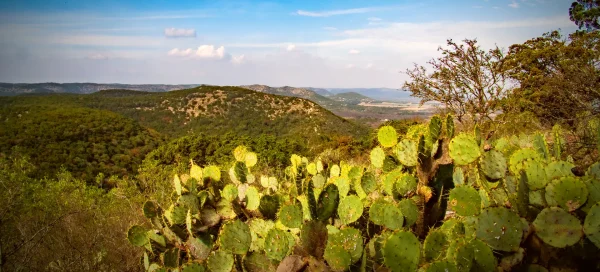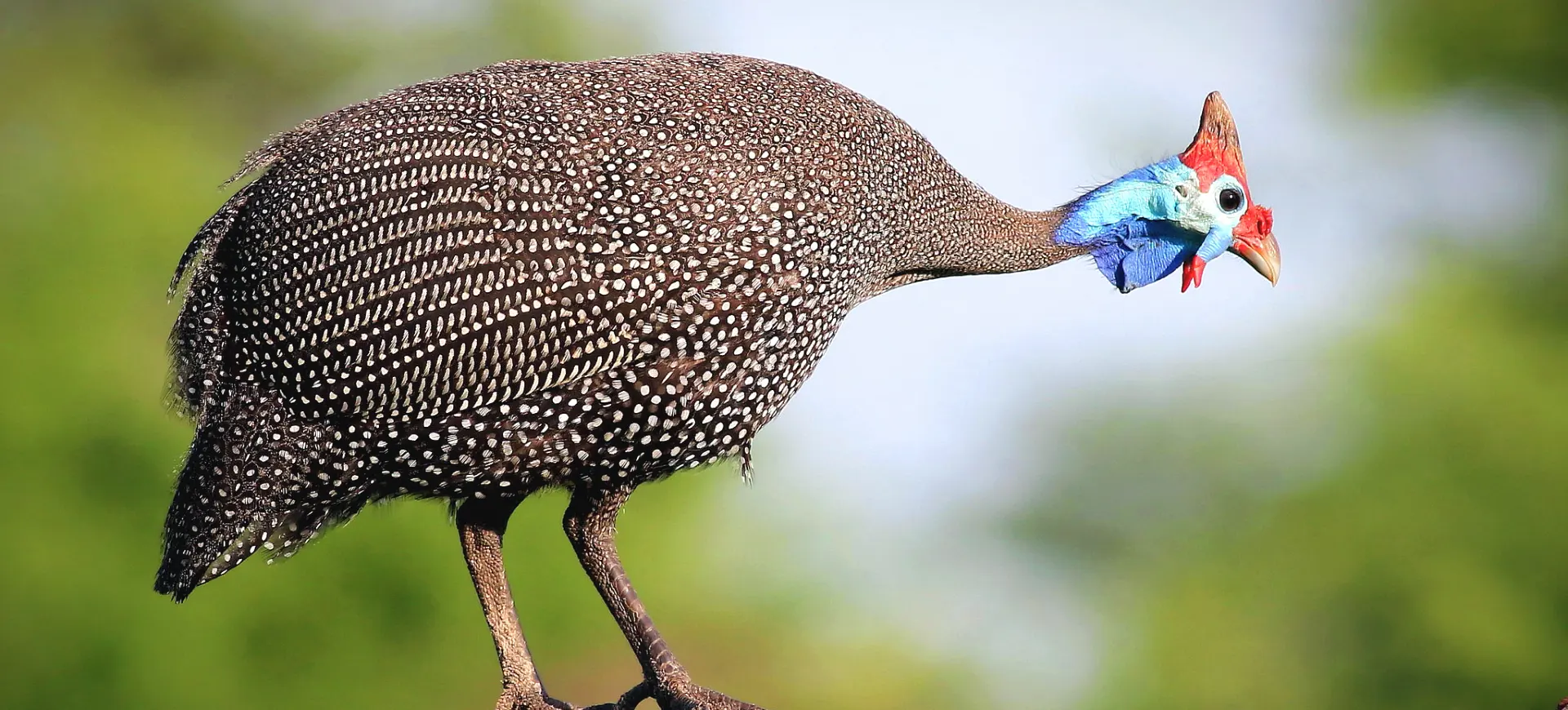Overview
The Eastern Crested Guineafowl, known scientifically as Guttera pucherani, is a distinctive bird species in various parts of Eastern Africa. It is easily recognizable by its unique appearance, characterized by dark grey or black plumage dotted with white and a prominent crest of black feathers on its head. The bird’s beady red eyes, blue face, and short beak add to its striking appearance. The Eastern Crested Guineafowl is a ground-dwelling bird, preferring to forage in small flocks in the underbrush of forests and woodlands.
This species is part of the Numididae family, which includes other guineafowl species. The Eastern Crested Guineafowl is relatively medium-sized compared to other game birds, with strong legs adapted for running rather than flight. Although capable of short bursts of flight, it primarily uses its wings to escape predators or to roost in trees at night. The bird’s call is a distinctive and loud series of ‘kek-kek-kek’ sounds, often heard in the early morning or late evening.
Socially, Eastern Crested Guineafowls are gregarious and are commonly found in groups. These groups can range from small family units to larger flocks, especially outside the breeding season. During the breeding season, pairs become more territorial and less tolerant of others. These birds play a crucial role in their ecosystem, primarily as seed dispersers and prey for larger predators.
Taxonomy
Kingdom
Phylum
Class
Order
Family
Genus
Species
Sub Species
Type
Physical Description:
The Eastern Crested Guineafowl exhibits a robust and rounded body with a size that typically ranges between 40 to 50 centimeters in length. Its most striking feature is the black crest of feathers on its head, which contrasts sharply with its predominantly dark plumage speckled with white spots. The bird’s face is bare with blue skin and red around the eyes, adding to its distinctive look.
The sexes are similar in appearance, although males are generally slightly larger than females. In terms of physique, the Eastern Crested Guineafowl possesses strong, muscular legs well-adapted for ground dwelling and running. The short and rounded wings suggest a lifestyle more reliant on running than flying. The tail is also short and typically held upright. The plumage offers excellent camouflage in the dappled light of its forest habitat, enabling it to remain concealed from predators.

Lifespan: Wild: ~10 Years || Captivity: ~15 Years

Weight: Male: 3.3 lbs (1.5 kg) || Female: 2.9 lbs (1.3 kg)

Length: Male: 20-22 inches (50-55 cm) || Female: 18-20 inches (45-50 cm)

Wingspan: Male & Female: 59-71 inches (150-180 cm)

Top Speed: 22 mph (35 km/h)
Characteristic:
Native Habitat:
The Eastern Crested Guineafowl inhabits a variety of habitats across Eastern Africa. Their preferred habitats are primarily dense forests and woodlands, where they find ample food and shelter. These birds are well-adapted to living in environments with thick underbrush, which provides them with cover from predators and extreme weather conditions.
The species is also found in forest-savanna mosaics, where forest patches are interspersed with grassland. This habitat diversity allows them to exploit different food sources and ecological niches. The Eastern Crested Guineafowl’s ability to thrive in diverse habitats has been key to its survival and distribution across different ecological zones in Africa.
Biogeographical Realms:
Continents:
Diet:
Diet & Feeding Habits:
The Eastern Crested Guineafowl is primarily an omnivore with a diet that includes many foods. In the wild, they feed on seeds, fruits, insects, and small invertebrates, which they forage from the forest floor. This varied diet is crucial for their nutrition and energy needs, particularly foraging in their natural habitat. They use their strong beaks to peck at food items and can dig into the soil for insects and roots.
These birds also play an important role in seed dispersal and pest control in their ecosystems. They consume seeds from various plant species, aiding in plant propagation through their droppings. Additionally, their consumption of insects and invertebrates helps control the population of these potential pests. In captivity, their diet is supplemented with additional nutrients to ensure their health and well-being.
Mating Behavior:
Mating Description:
The mating system of the Eastern Crested Guineafowl is predominantly monogamous, with pairs forming strong bonds during the breeding season. The breeding season usually coincides with the rainy season, providing ample food resources for raising chicks. During this period, males engage in elaborate displays to attract females, which include vocal calls and physical posturing. Once a pair is formed, they work together to build a nest, usually a simple scrape on the ground hidden under dense vegetation or brush. The female lays a clutch of eggs, usually ranging from 6 to 12 in number, and incubates them for about 26 to 28 days. The male typically stays near the nest during this period, guarding and protecting the female and the eggs. This shared responsibility increases the chances of successful hatching.
After hatching, both parents are involved in caring for the chicks. The young are precocial, relatively mature and mobile shortly after hatching. They follow their parents to learn foraging skills and to find food. The chicks can fly at a very young age, which is crucial for escaping predators and reaching safe roosting spots.
Reproduction Season:
Birth Type:
Pregnancy Duration:
Female Name:
Male Name:
Baby Name:
Social Structure Description:
The Eastern Crested Guineafowl exhibits a social structure that is both complex and adaptable. Outside the breeding season, these birds are typically found in flocks, ranging from a few individuals to over twenty. These flocks provide safety in numbers, as individuals can alert each other to the presence of predators. The flocks forage together, and their social interactions include a range of vocalizations and body language.
Within these flocks is a social hierarchy, with dominant birds often leading the group. This hierarchy is maintained through various behaviors, including pecking and posturing. During the breeding season, however, the social structure shifts as pairs form and become more territorial. At this time, the birds focus on mating and raising their offspring, often leading to the temporary dissolution of the larger social groups.
Groups:
Conservation Status:
Population Trend:
The Eastern Crested Guineafowl, while not currently endangered, faces threats that could impact its population numbers in the future. Habitat loss due to deforestation and agricultural expansion is a significant concern. This loss of habitat reduces the space available for the birds to live and forage and fragments populations, making them more vulnerable to other threats.
Despite these challenges, the population of the Eastern Crested Guineafowl remains relatively stable across its range. This is largely due to the bird’s adaptability to different habitats and ability to forage on various food sources. Protected areas and national parks play a crucial role in conserving the species, providing safe habitats away from human encroachment and hunting.
Population Threats:
The primary threat to the Eastern Crested Guineafowl is habitat loss, driven by deforestation, agricultural expansion, and urbanization. These activities reduce the available habitat and fragment populations, making them more susceptible to the effects of inbreeding and local extinctions. Additionally, hunting for meat and feathers poses a threat, particularly in areas where hunting regulations are poorly enforced.
Climate change is another emerging threat, as it can alter habitat conditions and food availability. Extreme weather events, changes in rainfall patterns, and rising temperatures can all impact the survival and reproductive success of the Eastern Crested Guineafowl. Conservation efforts are needed to mitigate these threats and ensure the species’ long-term survival.
Conservation Efforts:
Conservation efforts for the Eastern Crested Guineafowl primarily focus on habitat protection and management. Establishing and maintaining protected areas, such as national parks and reserves, is crucial for providing safe habitats for these birds. These areas safeguard vital breeding and foraging grounds and help maintain healthy ecosystems.
Education and community involvement are also key components of conservation strategies. Raising awareness about the importance of the Eastern Crested Guineafowl and its role in the ecosystem can help reduce hunting pressures and encourage habitat conservation. Community-based conservation programs involving local people in protecting and managing wildlife habitats are increasingly recognized as effective ways to conserve the species.
Additional Resources:
Fun Facts
- Eastern Crested Guineafowls can run quickly on the ground, often preferring to sprint away from danger rather than fly.
- Their unique crest is made of slender feathers that resemble hair.
- These birds are known for their loud and distinctive calls, especially during the early morning and evening.
- They play a significant role in controlling insect populations, as insects form a large part of their diet.
- Eastern Crested Guineafowls often dust bathe a behavior that helps them maintain their feather health.
- Chicks are born able to run and feed themselves almost immediately after hatching.
- These birds have a wide range of vocalizations used for communication within the flock.
- In some African cultures, the Eastern Crested Guineafowl symbolizes resourcefulness and communal living.
- Their plumage provides excellent camouflage in the dappled light of their forest habitats.
- The species has been featured in African folklore and storytelling, often symbolizing communal values and vigilance.








